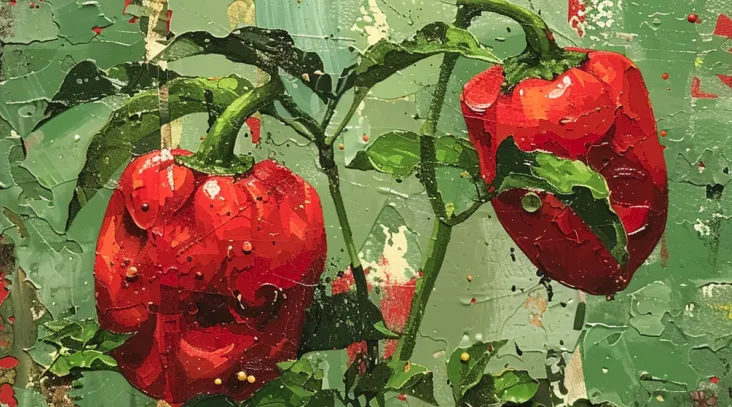
Using Bromelain Application to Inhibit the Spread of the Tobacco Mosaic Virus and Promote Tissue Regeneration in Red Bell Pepper Plants
Abstract¶
Plant viruses are a prevalent issue as they pose detrimental effects on agriculture, the food economy, and numerous individuals worldwide. One major effect of these viruses is tissue necrosis (breakdown of tissue), which plays a significant role in the decrease of crop yields. This study focused on the Tobacco Mosaic Virus (TMV), which infects over 350 plant species, causes necrotic symptoms, and exhibits a high transmission rate. Presently, various pesticides are in use that cause health issues in humans and are ineffective as some plants exhibit resistance. Moreover, this research aims to inhibit the spread of TMV in red bell pepper plants and promote tissue regeneration using an enzymatic approach since some enzymes have defense capabilities. A protease derived from pineapple, bromelain, was implemented due to its antimicrobial and anti-inflammatory properties. Bromelain was introduced to the plants as a pre-treatment before infection of TMV to analyze potential antiviral effects. Additionally, bromelain appeared to have correlations with a defensive enzyme located within plants known as phenylalanine ammonia lyase (PAL), which initiates the production of secondary metabolites. Using ImageJ software, the amount of plant tissue damage was highlighted and calculated, and a PAL assay was later conducted in conjunction with UV-Vis Spectroscopy to determine the level of PAL within the infected plants. Based on the experimental results, higher concentrations of bromelain contributed to lower levels of PAL, while lower concentrations of bromelain contributed to higher levels of PAL, indicating that higher treatment concentrations produced more antiviral activity.
Introduction¶
Tissue necrosis is a common result of most diseases and occurs in numerous living organisms during or after disease introduction. Particular diseases that cause tissue damage are viral infections which overtake an organism and replicate within the host, weakening defense mechanisms and promoting conditions detrimental to overall health. A major field that experiences these negative effects is agriculture, suffering losses of approximately 30 billion dollars each year globally due to plant viruses Fraser & Chapple, 2011 which are also responsible for about half of crop losses Hilaire et al., 2022. Additionally, plant viruses are connected to the issue of starvation in various areas of the world as they lead to lower crop yields and poorer quality of the crops produced Jones, 2021. The Tobacco Mosaic Virus (TMV) was first discovered in the late 1800s and is known to infect over 350 plant species Mamo, 2019. The ability of this virus to remain active even when the plant tissue dies creates a major issue as this causes higher rates of transmission and increased levels of crop loss. In response, a variety of pesticides are constantly in use, which have been known to cause gastrointestinal, respiratory, carcinogenic, and other health issues in humans and harm from an environmental standpoint Nicolopoulou-Stamati et al., 2016. With such issues, identifying a safe, effective, and efficient way to reduce viral diseases and alleviate symptoms of tissue necrosis in plants is crucial. A possible direction is the application of enzymes to enhance defense systems within a plant during infection, which can lower the effect of disease through various counteractions Prasannath, 2017. The ability of enzymes to catalyze chemical reactions is necessary for most life processes, and in a situation of tissue damage due to disease, enhancing enzyme activity to optimal levels is essential for proper recovery Anand et al., 2007.
Moreover, this research investigates the ability of bromelain, a protease derived from pineapple, to inhibit TMV within red bell pepper plants. Bromelain is currently used as a dietary supplement and anti-inflammatory treatment for humans, however, it possesses numerous antimicrobial properties that have been primarily studied against bacteria and fungi, but rarely viruses López-García et al., 2012. This study aims to identify the efficacy of bromelain as a pre-treatment to combat TMV and exhibit antiviral activity within the infected plants. Furthermore, this research could reveal the antiviral capacities of bromelain, which could be beneficial in enhancing agricultural practices and serving as a potential method of biocontrol.
A particular enzyme that is being investigated in this research is phenylalanine ammonia lyase (PAL) because this compound is essential for the initiation of the phenylpropanoid pathway in plants and is responsible for the production of secondary metabolites such as lignin and phytoalexin during plant infection Dong & Lin, 2021. A major focus of this study is to identify the relationship between bromelain and the compound PAL to observe how bromelain affects PAL activity in plants during infection with TMV. Additionally, when defense-related enzymes are activated early on in plant-defense pathways, the prevention of microbial accumulations is likely Thakker et al., 2013. Therefore, using a pre-treatment is an effective approach as plants tend to acquire disease later on, and increasing defense prior to infection is essential Prasannath, 2017. To test the efficacy of the bromelain pre-treatment, varying concentrations of bromelain are used to ensure which is the most optimal in producing antiviral effects. Based on the antiviral, antimicrobial, anti-inflammatory, and protease properties of bromelain, the plants will exhibit antiviral activity, and tissue will be preserved when red bell pepper plants infected with TMV are pre-treated with bromelain.
Materials and Methods¶
Seed Planting and Germination Process Before being pre-treated with bromelain, red bell pepper plants were grown using a Jiffy Seed Starting Greenhouse kit which contains peat pellets for seed germination Figure 1. To initiate the germination process, the pellets were watered with about 35 mL of water and left to rise before seed planting. In total, 24 peat pellets were used with 3 seeds in each pellet, resulting in 72 red bell pepper plants. These pellets were watered with approximately 10 mL of water as needed over two weeks.
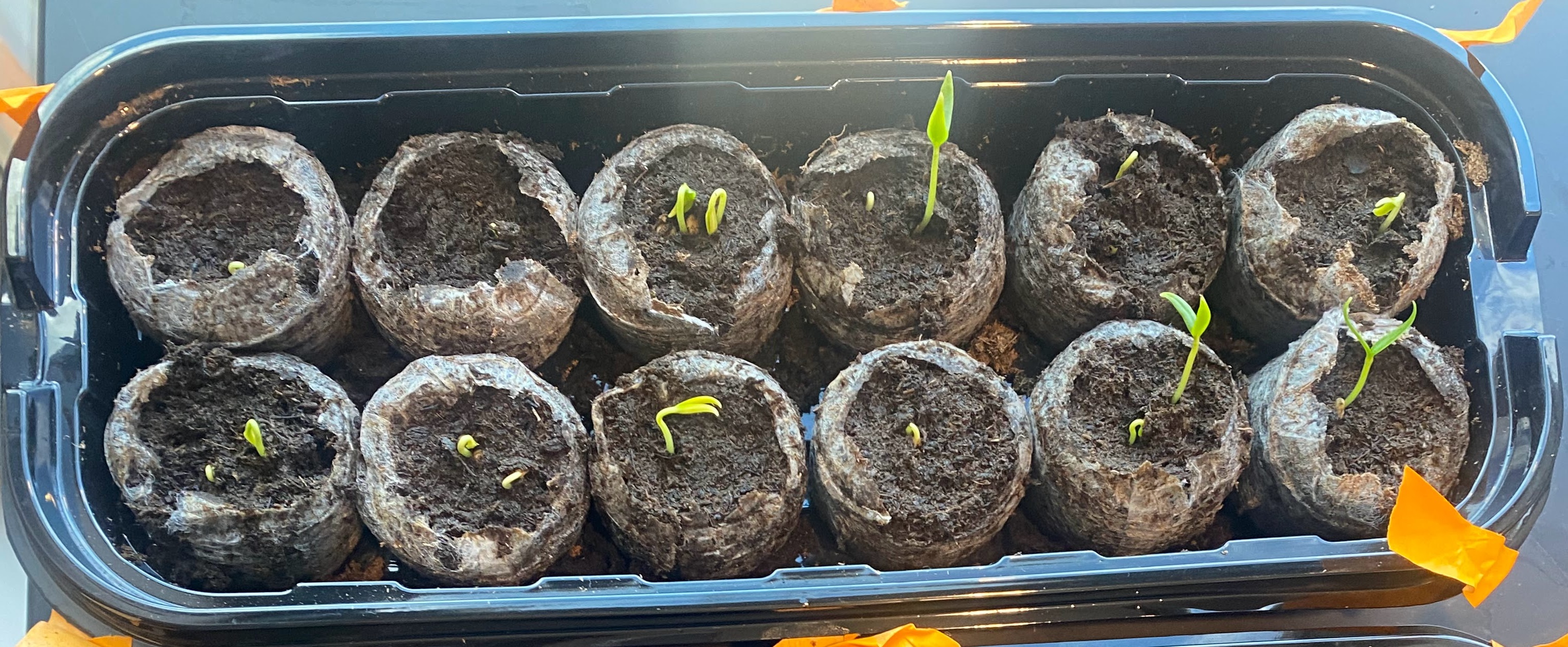
Figure 1:Beginning stages of plants in Jiffy Seed Starting kit
Preliminary Bromelain Treatment¶
To test the effects of bromelain on red bell pepper plants before infection, a preliminary treatment was conducted in which two plants from the sample size were treated with different concentrations of bromelain. The first plant received 110 mg of bromelain in a 20 mL solution of water and the second plant received 140 mg of bromelain in a 20 mL solution of water. Each concentration was administered using spray bottles and the plants were consistently watered and received adequate sunlight.
Transplanting and Plant Upkeep¶
After reaching adequate size, the plants were transplanted into smaller pots containing garden soil; Each plant received approximately 20-100 mL of water over a span of 7 weeks as needed and a sufficient amount of sunlight per day.
Bromelain Pre-Treatment Application¶
For preparation of the pre-treatment, approximately 40 mg, 80 mg, 200 mg, and 340 mg of bromelain were weighed out and placed in respective beakers containing 20 mL of spring water (these concentrations were based on previous studies that tested bromelain against bacteria and fungi). Each solution was then transferred to the corresponding spray bottles, which were swirled to ensure even distribution of the enzyme. Following this, each concentration was sprayed on the corresponding group of plants.
Inoculation¶
After two days, all the pre-treated plants were infected with TMV. To inoculate the plant leaves with TMV, a foam applicator was dipped in a vial of diatomaceous earth (abrasive) and dabbed on the leaf epidermis with support under the leaf using a paper towel pad Figure 2. The virus was then painted over the surface of the leaf with another foam applicator and left to air-dry before rinsing with sprays of water for about 3 seconds. This process was repeated for 4 leaves on each of the 22 red bell pepper plants, including a control group that did not receive pre-treatment.
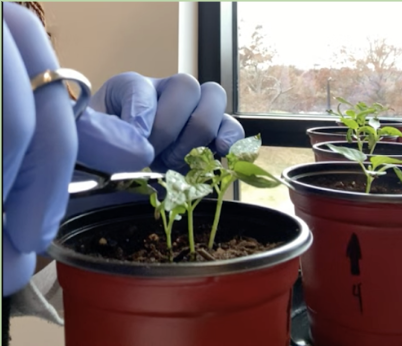
Figure 2:Treating the leaves
Microscope Imaging¶
Infected leaves from the treatment groups and the control group were collected and placed between glass plates for clear imaging. The respective samples were then aligned with the microscope camera for imaging Figure 3. Next, the images were uploaded into the Las X microscope software and acquired for further analysis Figure 4.
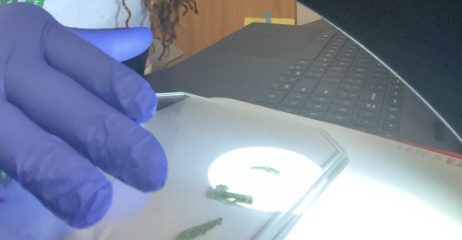
Figure 3:Collection of leaf samples
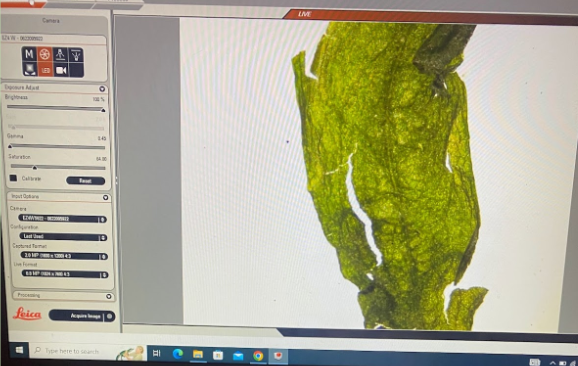
Figure 4:Alignment of leaf samples with microscope
ImageJ Software Analysis¶
To obtain numerical data regarding the amount of leaf damage produced, the software ImageJ was utilized. The images of the damaged leaves were first inputted into the software and were outlined to calculate the total leaf area. The color threshold settings were then changed to adjust the hue, saturation, and brightness levels to highlight the diseased regions of the leaves Figure 5. Lastly, the total leaf area and diseased area values were obtained in pixels and used to determine the percent tissue damage.
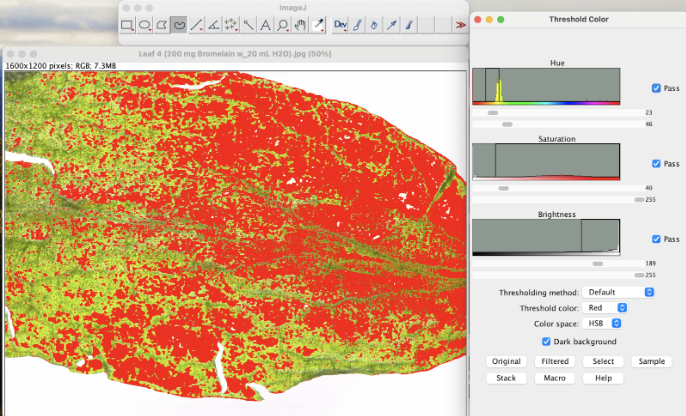
Figure 5:Adjustment of color threshold settings (i.e. hue, saturation, and brightness) to highlight tissue damage
Phenylalanine Ammonia Lyase (PAL) Assay¶
The infected plant tissue was collected (approximately 0.03 g) from each treatment group along with the control group and tested to determine PAL concentrations. To begin, each sample was homogenized in an ice water bath and centrifuged for 10 minutes. Next, supernatant was obtained from each tube and placed in new tubes. Appropriate reagents were then added to the samples and the tubes were vortexed.
UV-Visible Spectroscopy¶
A 1 cm optical path along with a 290 nm wavelength was set for UV-Vis spectroscopy to calculate absorbance values. Using the samples from the PAL assay, 3 mL of each sample was transferred into cuvettes and placed in the spectrophotometer (Figure 6). Finally, the concentrations of PAL in the control and treatment samples were calculated.
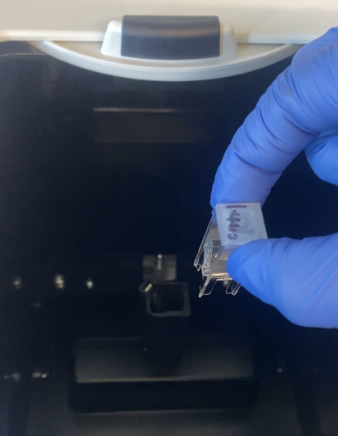
Figure 6:Transfer of sample cuvette into UV-Vis spectrophotometer
Results and Discussion¶
Preliminary Bromelain Treatment¶
Based on the bromelain concentrations administered to the plants (110 mg and 140 mg), it could be understood qualitatively that bromelain had no adverse effects on the plants and seemed to enhance the growing process. The treated plants had a stronger structure and were less flimsy compared to the untreated plants, indicating that bromelain most likely contributes to stronger cell walls within plant cells. In addition, the bromelain-treated plants could go longer periods without water based on increased posture that was observed, highlighting possible capacities of bromelain to promote water retention. It was also observed that the higher concentration of bromelain (140 mg) contributed to healthier outcomes qualitatively compared to the lower concentration (110 mg).
Leaf Damage Calculations¶
After the ImageJ processing of the infected leaves for the rest of the sample size, the total and diseased area values were obtained in pixels. Based on the data, higher concentrations of bromelain were associated with greater leaf surface areas, while lower concentrations of bromelain contributed to lower leaf surface areas. The percent tissue damage values amongst the leaves treated with higher bromelain concentrations had larger ranges than those treated with lower bromelain concentrations, highlighting the efficacy of bromelain against TMV in higher dosages. In addition, the average percent damage was higher amongst leaves with greater bromelain concentrations (28.55% for 340 mg & 33.26% for 200 mg) and lower amongst leaves with smaller bromelain concentrations (19.11% for 80 mg & 8.46% for 40 mg), which could be attributed to uncontrolled conditions such as the varying surface areas, the amount of sunlight each plant received, the varying sizes of the leaves, and potential errors in outlining the leaves using the ImageJ software.
Phenylalanine Ammonia Lyase (PAL) Assay¶
Using the absorbance values from the UV-Vis Spectroscopy and the equation provided by the Elabscience PAL Assay Kit, PAL activity was calculated for each treatment group and the control. From the calculation performed, the results were directly correlated with UV-Vis spectroscopy results as there was an inverse relationship between PAL activity and bromelain concentrations; PAL activity was higher in plants treated with lower concentrations of bromelain and lower in plants treated with higher concentrations of bromelain. With this information, it could clearly be understood that bromelain exhibited antiviral activity and was effective as a pre-treatment against TMV in the infected plants, especially with higher dosages.
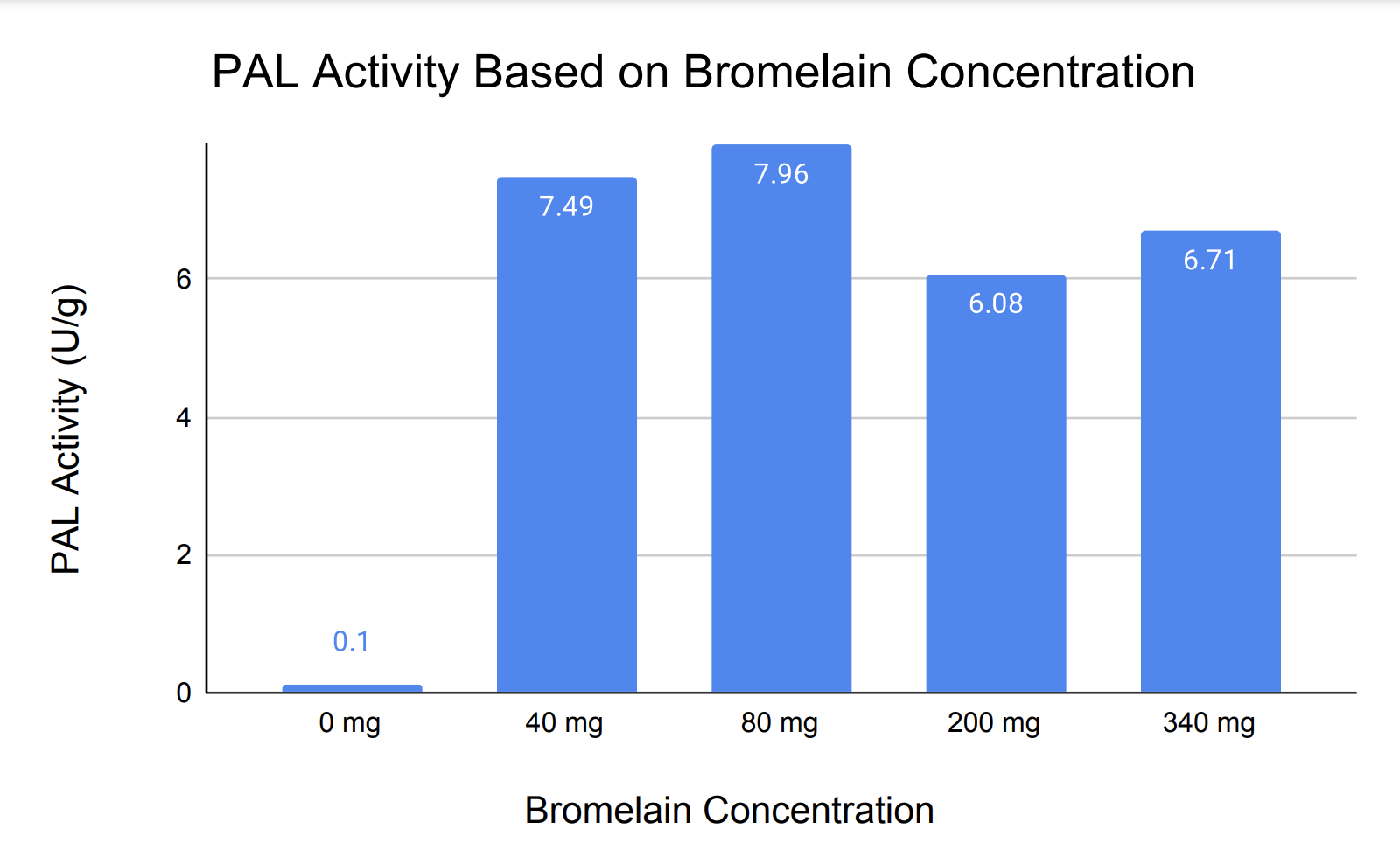
Figure 7:Based on the graph, PAL activity was higher in plants treated with lower bromelain concentrations and lower in plants treated with higher bromelain concentrations. This suggests that bromelain in higher dosages contributes to increased antiviral activity as PAL enzyme activity is not as high, while lower dosages contribute to antiviral activity on a lower scale. With little to no PAL activity in the control, bromelain overall appeared to have antiviral effects.
UV-Vis Spectroscopy¶
According to the results obtained by UV-Vis spectroscopy, leaves with higher concentrations of bromelain (340 mg and 200 mg) had lower PAL activity compared to leaves treated with lower bromelain concentrations based on the absorbance values.
This most likely occurred because higher bromelain concentrations contribute to increased levels of antiviral activity, decreasing the need for PAL within the plant, while lower bromelain concentrations contribute to antiviral activity on a lower scale, indicating a higher need for PAL activity. Moreover, higher concentrations of bromelain appeared to be more optimal in assisting plant defense mechanisms and produced greater antiviral activity as PAL levels were lower.
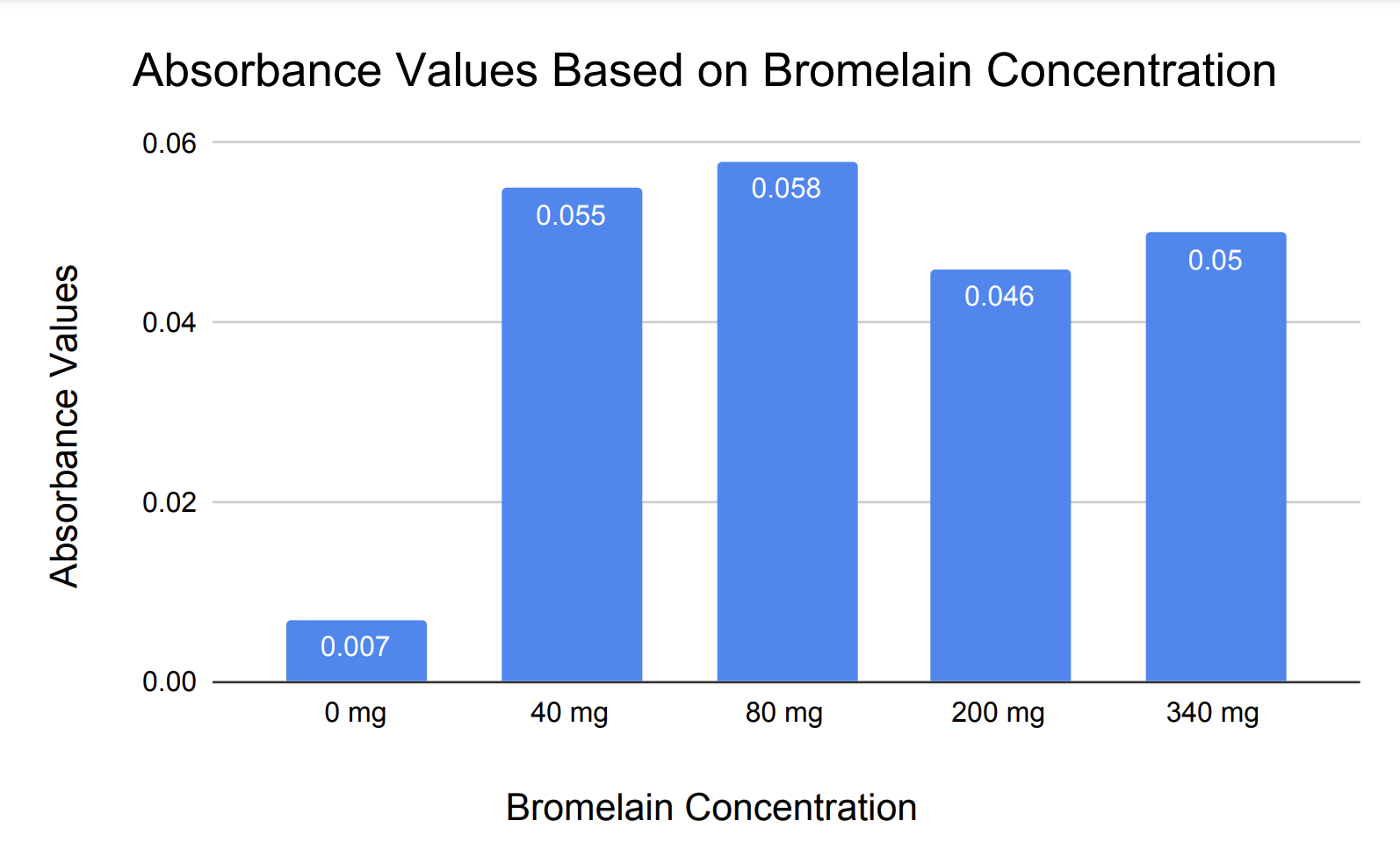
Figure 8:From the UV-Vis results, absorbance values were higher in plants treated with lower bromelain concentrations and lower in plants treated with higher bromelain concentrations. In the control, there was no significant absorbance value, which suggests bromelain’s efficacy as an antiviral plant treatment.
Limitations¶
In this experiment, there were also uncontrolled circumstances that could have affected the results. To begin, the growing conditions of the pepper plants posed variations in the leaf sizes as some plants were closer to sunlight than others, which could have affected plant tissue damage calculations. Additionally, when applying the bromelain pre-treatment, it was not ensured that all the solution reached the plants as the liquid also absorbed into the soil and touched external surfaces. Another aspect that impacted this experiment was the lack of repeated trials due to time constraints, which could have affected the conclusiveness of the results.
Conclusion¶
From the data obtained, the use of bromelain as a pre-treatment was effective against TMV as antiviral activity was produced within the infected plants. Moreover, this research highlights the potential of implementing defense enzymes as a mechanism against plant viruses and the capacity of natural substances to combat plant disease effectively with minimal adverse effects. With higher bromelain concentrations, lower PAL values were reflected, which indicated that these concentrations were more optimal as more antiviral activity was exhibited. This was also confirmed with the qualitative data as lower tissue damage was observed in treatment groups with higher bromelain concentrations, and higher tissue damage in treatment groups containing lower bromelain concentrations. Furthermore, this research is groundbreaking in the agricultural field as it could change the perspective of farming and positively impact many individuals worldwide since the use of this enzymatic approach offers newer potential for crop yield and presents a solution to numerous plant diseases.
I would like to thank Mrs. Jennifer Williams for assisting me with my project idea and being a supportive research mentor. I would also like to extend my gratitude to the Research in Biology program and Summer Research and Innovation program at the North Carolina School of Science and Mathematics-Morganton for offering me this opportunity and facilitating my research.
Copyright © 2024 Duru. This is an open-access article distributed under the terms of the Creative Commons Attribution 4.0 International license, which enables reusers to distribute, remix, adapt, and build upon the material in any medium or format, so long as attribution is given to the creator.
- PAL
- phenylalanine ammonia lyase
- TMV
- Tobacco Mosaic Virus
- Fraser, C. M., & Chapple, C. (2011). The Phenylpropanoid Pathway in Arabidopsis. The Arabidopsis Book, 9, e0152. 10.1199/tab.0152
- Hilaire, J., Tindale, S., Jones, G., Pingarron-Cardenas, G., Bačnik, K., Ojo, M., & Frewer, L. J. (2022). Risk perception associated with an emerging agri-food risk in Europe: plant viruses in agriculture. Agriculture & Food Security, 11(1). 10.1186/s40066-022-00366-5
- Jones, R. A. C. (2021). Global Plant Virus Disease Pandemics and Epidemics. Plants, 10(2), 233. 10.3390/plants10020233
- Mamo, J. (2019). Antibacterial and Anticancer Property of Bromelain: A Plant Protease Enzyme from Pineapples (Ananas comosus). Current Trends in Biomedical Engineering & Biosciences, 19(2). 10.19080/ctbeb.2019.19.556009
- Nicolopoulou-Stamati, P., Maipas, S., Kotampasi, C., Stamatis, P., & Hens, L. (2016). Chemical Pesticides and Human Health: The Urgent Need for a New Concept in Agriculture. Frontiers in Public Health, 4. 10.3389/fpubh.2016.00148
- Prasannath, K. (2017). Plant defense-related enzymes against pathogens: a review. AGRIEAST: Journal of Agricultural Sciences, 11(1), 38. 10.4038/agrieast.v11i1.33
- Anand, T., Chandrasekaran, A., Kuttalam, S., Raguchander, T., Prakasam, V., & Samiyappan, R. (2007). Association of some plant defense enzyme activities with systemic resistance to early leaf blight and leaf spot induced in tomato plants by azoxystrobin andPseudomonas fluorescens. Journal of Plant Interactions, 2(4), 233–244. 10.1080/17429140701708985
- López-García, B., Hernández, M., & Segundo, B. S. (2012). Bromelain, a cysteine protease from pineapple (Ananas comosus) stem, is an inhibitor of fungal plant pathogens: Antifungal bromelain for crop protection. Letters in Applied Microbiology, 55(1), 62–67. 10.1111/j.1472-765x.2012.03258.x
- Dong, N., & Lin, H. (2021). Contribution of phenylpropanoid metabolism to plant development and plant–environment interactions. Journal of Integrative Plant Biology, 63(1), 180–209. 10.1111/jipb.13054
- Thakker, J. N., Patel, S., & Dhandhukia, P. C. (2013). Induction of Defense-Related Enzymes in Banana Plants: Effect of Live and Dead Pathogenic Strain of Fusarium oxysporum f. sp. cubense. ISRN Biotechnology, 2013, 1–6. 10.5402/2013/601303
